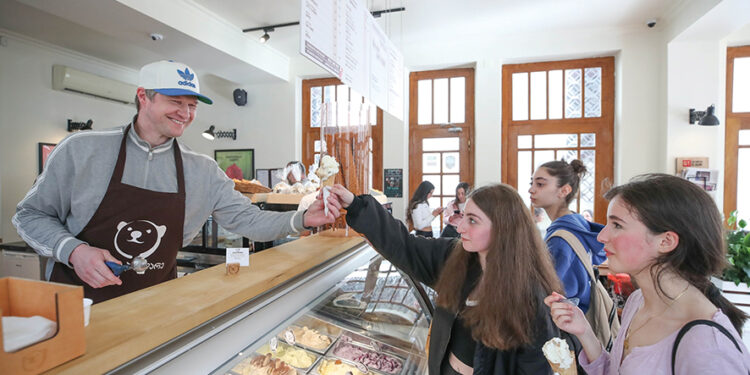Eight hundred and forty-nine tons of ice cream. That’s what Georgia has imported in just the first half of 2025. For a country of vineyards and walnut orchards, the figure is striking: nearly a thousand tons of frozen sweetness, most of it arriving from Turkey, Ukraine, Armenia, Russia, and France. At the same time, Georgia exported a modest 68 tons — almost five times more than last year, yet still a drop in the global freezer.
Georgia imported 849 tons of ice cream in the first half of 2025
On paper, this looks like trade statistics. In reality, it reads like cultural anthropology. Ice cream, which appears to be the most innocent of pleasures, has always been a barometer of identity, aspiration, and belonging.
The story of ice cream is as cosmopolitan as any commodity in history. Tang dynasty China had its frozen rice-milk mixtures. Renaissance Florence staged sorbetto as a spectacle of courtly refinement. Industrial America turned ice cream into a democratic symbol of Sunday leisure, once refrigeration became reliable.
Everywhere it went, ice cream carried more than sugar and fat. It carried desire, status, and the performance of modernity. In Georgia, today, an imported tub of French vanilla or Turkish pistachio doesn’t simply fill a freezer; it signals alignment with a global culture of consumption. In sociologist Sidney Mintz’s language, sweetness is never just about taste — it is about power and aspiration.
Nearly $4.6 million spent in six months on foreign ice cream versus $767,000 earned from exports
Here the paradox emerges. Georgia produces world-class dairy, fruit, honey — everything necessary for ice cream of extraordinary quality. Yet the domestic industry is dwarfed by imports. Nearly $4.6 million spent in six months on foreign ice cream versus $767,000 earned from exports.

Economists might call this a dependency dynamic: a country exporting bulk wine or raw nuts while importing the processed luxuries. But the more intriguing angle is cultural. Imported ice cream functions as a middle-class performance of cosmopolitan life, a small ritual of global belonging.
At the same time, Georgia’s modest exports to Armenia and Azerbaijan — though only 68 tons — increased by almost 400% compared to last year. This is not yet an industry. It is more like a regional whisper: Georgia testing the waters of boutique ice cream diplomacy.
Georgia’s modest exports to Armenia and Azerbaijan increased by almost 400% compared to last year
No account of Georgian ice cream can ignore the Soviet shadow. For generations, plombir was the most coveted of mass luxuries: the frozen promise of summer afternoons, the rare commodity that felt abundant. Queues for ice cream kiosks were collective rituals of waiting, desire, and reward.
Today, the post-Soviet consumer faces a different horizon. French, Turkish, or Ukrainian ice cream is not only about flavor but about stepping beyond the Soviet palate. Nostalgia and aspiration now coexist in every freezer aisle. Buying imported ice cream is a way of both remembering and transcending.
Read closely, these trade numbers tell us more than customs reports. They sketch a map of Georgia’s cultural positioning. Global integration — the freezer as proof of globalization. Shifting class markers — the rise of imported indulgences as symbols of aspiration. Economic irony — the country with matsoni and orchards still leans on Turkey for pistachio cones.
Food here becomes theory. As Claude Lévi-Strauss argued, cooking systems are cultural codes; frozen desserts are no exception. Georgia’s growing appetite for imports is less about sugar and cream than about navigating identity between tradition and modernity, self-sufficiency and dependency, nostalgia and aspiration.
Ice cream is never trivial. Each ton is freighted with meaning — social, economic, historical. A Georgian child biting into a French chocolate-coated bar consumes more than calories; they consume an idea of Europe. An Azerbaijani buyer of Georgian ice cream tastes not just dairy but the soft projection of Georgian identity.
Trade statistics, in this sense, become a cultural text. To read them is to read the future: a small, fragile, delicious story about how a country positions itself in the world. And so, in the summer of 2025, as Georgia imports its 849th ton of ice cream, the question lingers: is this just dessert, or is it a philosophy of belonging — frozen, packaged, and ready for export?
By Ivan Nechaev














